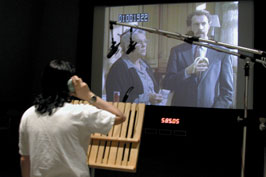The Man Behind the Voice - Getting the Most from ADR
By Tristan Rose | 12-Dec-2014

The best compliment I can receive for my ADR work is when no one notices it, and, if it's really good, it will never be talked about. Simply put, ADR is the re-recording of dialogue in TV, film or advertising and I have had the privilege of working with incredibly talented and high profile actors and directors on a wide-range of film and critically acclaimed TV series.
The question I am often asked about my work is, "Why is it so important?" and the answer lies in why a film or TV show is even made - a story is there to be told and if the audience can't hear or understand the dialogue, a key part of the narrative is missed and the audience can become disengaged. Unintelligible dialogue has hit the headlines this year with both film and TV shows being criticised. Audience and viewing figures have suffered on certain shows which is never what a production company or broadcaster want to see.
There are a variety of different ways to record dialogue sound on set but even the best location sound recordists can't always capture clean sound. Wind and rain machines, generators and other environmental factors on set can all cause issues, boom mics can often compromise the composition of a shot and a lavalier microphone (also known as a clip or personal mic) can be affected by the actor’s movement resulting in rustling or muffling across the dialogue.
As with most other industries, production budgets have reduced resulting in tighter shoot schedules and increased time pressures on set. This means there is often little time for the location recordist to prepare or indeed for a scene to be re-shot for audio alone. Because of this, ADR is invariably the best and most cost effective way to achieve audible yet realistic dialogue.
I have worked on a variety of comedy shows, dramas and feature films, with world-class directors and some of the best acting talent around the world - from Hollywood actors Javier Bardem and Marion Cotillard to established and home-grown stars Timothy Spall, Thandie Newton and Vanessa Redgrave. To work on critically acclaimed BBC shows Line of Duty and The Honourable Woman - shows I would make a point of watching at home - has been particularly special, as was working on long-term TV projects such as The White Queen and US TV series Rogue where I was able to create a strong rapport with both the acting talent and production team alike.
Actors can often feel resentful about taking part in ADR sessions. They feel that they have done the work once and are reluctant to repeat it, just for sound. I therefore go to great pains to ensure it is as relaxing and enjoyable an experience as possible for them - even if I am asking them to submerge their head in a tank of water to recreate a drowning scene, or be thrown around the studio by a friend for a fight sequence!
Our Soho studios have a reputation for being clean, comfortable and calm. We have a great team here who are always on hand to make a perfect cup of tea or fetch lunch from one of the countless delis and cafes on our doorstep. We also know a lot of the TV and film actors we work with from their commercial work and we make a point of learning our clients' likes and dislikes so they feel they are coming to somewhere they know and trust and are therefore able to give their best performance possible.
Ask any ADR recordist about tricky environments to work with and they will invariably mention exterior scenes, which are very difficult to recreate in studio. A main reason for this is the fact that people naturally speak louder when they are outside, so often I will have to get the actors to do this - although it can feel weird at first.
We record in the best acoustically treated rooms in Soho and whilst I always aim to use the exact same microphones that the actors had on set, I have had great results matching dialogues with my standard studio set-up of a Schoeps CMIT 5U and a Sanken cos11.
The main pieces of software I use, with ProTools, are EdiCue and EdiPrompt - the former is a cueing software that creates ADR cues and scripts and generates midi files that trigger visual wipes and audio beeps when used in conjunction with EdiPrompt. This gives the actor their line as text on screen and a visual and audio cue for timing. I also frequently use ISDN and Source-Connect to link-up with studios around the world - when an actor and/or production team cannot all be in the same place at the same time.
Above all, I believe that it's not technology, but the performance of an actor, that is the key to success in ADR. My focus is always on matching the pitch, vocal tone, and loudness of projection. To do that you must gain the actors trust, working around them and tailoring your work to their needs. When I watch the projects I have been involved with, on TV or at the cinema, it makes me very proud to have played a small part in the final performance.
Comments

